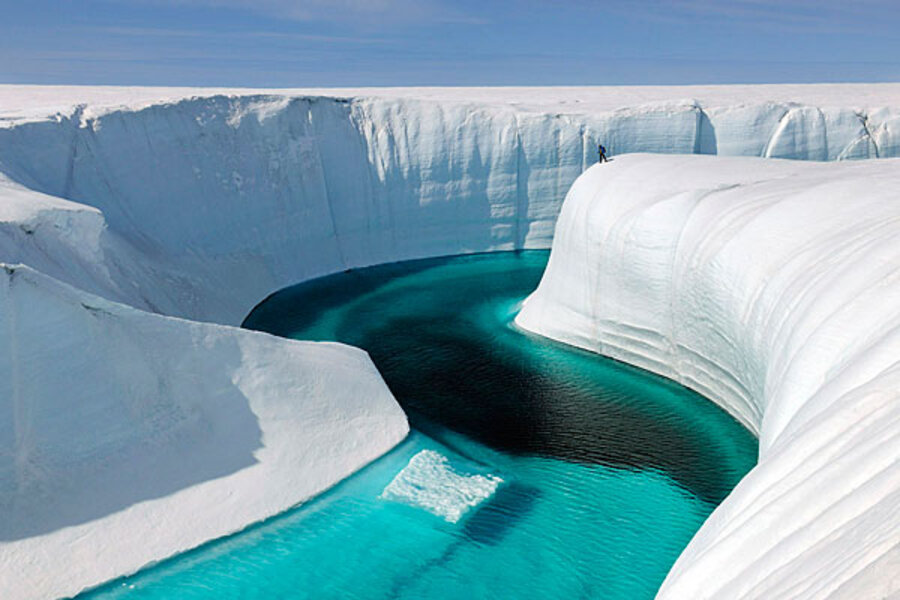Are polar ice sheets shrinking? Report offers definitive answer at last.
Loading...
A team of scientists has combed through 20 years of data to arrive at what it says is the first comprehensive report on how much ice Greenland and Antarctica are losing as the global climate warms – and how much this trend has contributed to sea-level rise.
Previous studies, done over certain parts of these regions and over various time periods, had led to disagreement concerning these questions. Some studies showed catastrophic ice loss, and others showed a small net gain.
The team reporting in Friday's issue of the journal Science says that when these data are synthesized and looked at holistically, as this report does, the apparent contradictions disappear and a single picture emerges.
The fuller picture suggests that, collectively, the ice sheets that cover Antarctica and Greenland are now losing three times as much ice each year as they did in the 1990s. All told, they lose about 344 billion tons of ice annually – about in the middle of previous estimates.
These losses push up sea levels about 1 millimeter (0.04 inches) a year. Since 1992, the trend has contributed 11 millimeters (0.43 inches) to sea-level rise – about 20 percent of total sea-level rise during that time, the team says.
Scientists say it will take years to develop models that can forecast how sea levels will fare by the end of the century.
“It remains unclear if such losses will decline or will level off or will accelerate further," says Ian Joughin, a glaciologist at the University of Washington in Seattle. "The melting needs monitoring to further understand the ice sheet processes leading to the change.”
The findings show that two thirds of the annual ice loss is from the Greenland sheet. Indeed, Greenland is losing five times as much ice each year as it did in the 1990s.
Antarctica provides a more nuanced picture. In East Antarctica, which holds at least four-fifths of the continent’s ice, the mass ice forms are stable – actually gaining slightly during the past 20 years. But these gains are eclipsed by losses in West Antarctica and on the Antarctic peninsula, which yield a net loss of ice for the continent annually and account for the remaining third of total annual ice-sheet loss detailed in the study.
The report is a “milestone,” because it provides a more precise estimate of ice-sheet losses, the researchers said during a Wednesday teleconference. Previously, scientists had to sort through as many as 30 independent data estimates collected over 50 years, and these often produced the conflicting results, said Andrew Shepherd of the University of Leeds in Britain, a project leader.
The report also offers new clarity on sea-level rise. A 2007 report by the UN's Intergovernmental Panel on Climate Change (IPCC), for example, observed the reduction in size of the ice sheets, but was not conclusive about its effects on sea levels.
Moreover, establishing a 20-year record of the ice sheets will help scientists understand the dynamics of what is going on. “We thought we understood ice sheets … but we realized we didn’t understand the physics of ice sheets very well,” said Erik Ivins of NASA's Jet Propulsion Laboratory in Pasadena, Calif., and another team leader
Ice sheets are one of several main drivers of sea-level rise. The others – which account for the other 80 percent of sea-level rise – include the melting of glaciers and the fact that water expands as it warms, meaning seas are expanding somewhat as the atmosphere heats up. By contrast, the melting of polar sea ice has no direct effect on sea levels, since the ice is already in the water.
Researchers warn that the 11 millimeters added to sea levels by declining ice sheets since the 1990s might not sound significant, but it could be – and the storm surge from hurricane Sandy pointed to some concerns.
“We don’t fully understand or appreciate yet the physics involved in storm surges. When you have 11 millimeters of increase in sea level, it’s still a lot of mass,” says Dr. Ivins. “Small changes in sea levels in certain places mean very big changes in the kind of protection of infrastructure that you need to have in place.”






